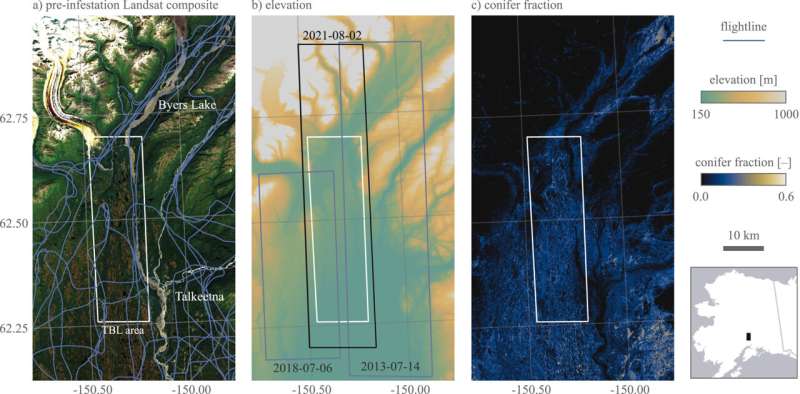This article has been reviewed according to Science X's editorial process and policies. Editors have highlighted the following attributes while ensuring the content's credibility:
fact-checked
trusted source
proofread
New way to spot beetle-killed spruce can help forest, wildfire managers

A new machine-learning system developed at the University of Alaska Fairbanks can automatically produce detailed maps from satellite data to show locations of likely beetle-killed spruce trees in Alaska, even in forests of low and moderate infestation where identification is otherwise difficult.
The automated process can help forestry and wildfire managers in their decisions. That's critical as the beetle infestation spreads.
The Alaska Division of Forestry and Fire Protection calls the spruce beetle "the most damaging insect in Alaska's forests."
The identification system by assistant professor Simon Zwieback at the UAF Geophysical Institute was detailed in the ISPRS Journal of Photogrammetry and Remote Sensing on May 18. Zwieback is also affiliated with the UAF College of Natural Science and Mathematics.
The work fills a knowledge gap: how to automatically map likely spruce beetle infestations in areas of low to moderate severity.
"We lack comprehensive statewide maps of beetle-killed trees because existing products largely rely on expert observations from airplanes, which are expensive and restricted in space and time," Zwieback said. "This limits stakeholders' ability to respond to the ongoing outbreak."
Alaska foresters now use survey flights, time-consuming manual interpretation of high-resolution imagery and automated analysis of coarser satellite imagery to find dead spruce in mixed forests. Coarser imagery can be used to identify entire stands of dead trees but not individual dead trees.
None of those identification methods, including Zwieback's, can determine the cause of an individual tree's death. The likelihood of beetle infestation is surmised because of its well-known presence and the damage already caused.
Zwieback's method combines the efficiency of automation with the detail of high-resolution satellite images.
"Using machine learning and high-resolution imagery is the way to go in mixed forests," Zwieback said.
Machine learning is a type of artificial intelligence that focuses on developing algorithms and statistical models that enable computers to learn from and make predictions or decisions based on data.
Zwieback's machine-learning algorithm is trained using known locations of dead spruce trees. During training, the algorithm learns to recognize dead spruce based on their characteristic shape and color, and contextual clues such as shadows. Once satisfactorily trained, it can rapidly and automatically identify dead spruce trees.
Zwieback tested the method on images of an approximately 167-acre study area west of a line from Talkeetna to Byers Lake. Forested regions of the study area consist of mixed stands of spruce and birch.
The region has been heavily affected by a beetle infestation that began in the mid-2010s.
Zwieback's method succeeded in identifying dead spruce in stands containing only a few dead trees.
Statewide, the infestation has affected approximately 2 million acres, mostly in Southcentral Alaska, since 2016. It had spread north to Cantwell and the Alaska Range mountains by 2020.
The death of large numbers of spruce results in several ecosystem changes and related consequences: Understory vegetation can change to grasses and shrubs, and dead branches can litter the floor. All of that adds to wildfire danger by putting more fuel at ground level.
Zwieback's method can help in decisions about fire prevention and suppression.
Decreased value of timber resources and the aesthetic deterioration of the landscape are additional concerns.
Zwieback is continuing his research.
"I would like to implement this for the entire state whenever new images come in," he said. "Remote sensing can help us understand the outbreak dynamics and inform our response to it, especially as it migrates into the Interior."
Zwieback said field sites have been set up on land owned by Ahtna, a Southcentral Alaska regional Native corporation, to better understand the progress and consequences of the outbreak as it moves into the Interior.
More information: S. Zwieback et al, Low-severity spruce beetle infestation mapped from high-resolution satellite imagery with a convolutional network, ISPRS Journal of Photogrammetry and Remote Sensing (2024). DOI: 10.1016/j.isprsjprs.2024.05.013
Provided by University of Alaska Fairbanks



















